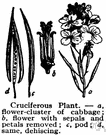sepal
Also found in: Thesaurus, Medical, Acronyms, Encyclopedia, Wikipedia.
se·pal
(sē′pəl)n.
One of the usually green leaflike structures composing the outermost part of a flower. Sepals often enclose and protect the bud and may remain after the fruit forms.
[New Latin sepalum, perhaps blend of Greek skepē, covering and Latin petalum, petal; see petal.]
sep′a·line (sĕp′ə-lĭn), sep′a·lous (-ləs) adj.
American Heritage® Dictionary of the English Language, Fifth Edition. Copyright © 2016 by Houghton Mifflin Harcourt Publishing Company. Published by Houghton Mifflin Harcourt Publishing Company. All rights reserved.
sepal
(ˈsɛpəl)n
(Botany) any of the separate parts of the calyx of a flower
[C19: from New Latin sepalum: sep-, from Greek skepē a covering + -alum, from New Latin petalum petal]
ˈsepalled, sepalous adj
Collins English Dictionary – Complete and Unabridged, 12th Edition 2014 © HarperCollins Publishers 1991, 1994, 1998, 2000, 2003, 2006, 2007, 2009, 2011, 2014
se•pal
(ˈsi pəl)n.
one of the individual leaves or parts of the calyx of a flower.
[< New Latin sepalum (1790)]
se′paled, se′palled, adj.
Random House Kernerman Webster's College Dictionary, © 2010 K Dictionaries Ltd. Copyright 2005, 1997, 1991 by Random House, Inc. All rights reserved.
se·pal
(sē′pəl) One of the separate, usually green parts extending from the base of a flower. Sepals look like small leaves, though in some plants they are colored like petals. As a group, they form the calyx, which surrounds and protects the flower bud. In some flowers, such as the poppies, the sepals fall off after the flower bud opens. See more at flower.
The American Heritage® Student Science Dictionary, Second Edition. Copyright © 2014 by Houghton Mifflin Harcourt Publishing Company. Published by Houghton Mifflin Harcourt Publishing Company. All rights reserved.
ThesaurusAntonymsRelated WordsSynonymsLegend:
Switch to new thesaurus
| Noun | 1. |  sepal - one of the green parts that form the calyx of a flower sepal - one of the green parts that form the calyx of a flowerfloral leaf - a modified leaf that is part of a flower calyx - (botany) the whorl of sepals of a flower collectively forming the outer floral envelope or layer of the perianth enclosing and supporting the developing bud; usually green |
Based on WordNet 3.0, Farlex clipart collection. © 2003-2012 Princeton University, Farlex Inc.
Translations
Collins Spanish Dictionary - Complete and Unabridged 8th Edition 2005 © William Collins Sons & Co. Ltd. 1971, 1988 © HarperCollins Publishers 1992, 1993, 1996, 1997, 2000, 2003, 2005
sepal
n → Kelchblatt nt
Collins German Dictionary – Complete and Unabridged 7th Edition 2005. © William Collins Sons & Co. Ltd. 1980 © HarperCollins Publishers 1991, 1997, 1999, 2004, 2005, 2007
Collins Italian Dictionary 1st Edition © HarperCollins Publishers 1995